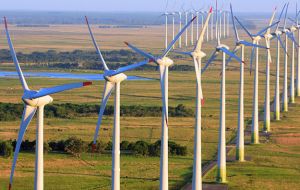MercoPress. South Atlantic News Agency
Historic win for wind energy in Brazilian government power auction
 Wind projects in the latest auction won 39% of the total capacity contracted
Wind projects in the latest auction won 39% of the total capacity contracted Wind farms have come out on top in the latest round of power auctions organized by Brazil’s government. Slowly letting go of government protection to compete head-to-head with historically cheaper fossil fuel energy, the wind power sector indicated its potential strength.
Forty-four wind power projects with a total capacity of 1067MW won this week in the auction while only two natural gas projects with a combined capacity of 1029MW were successful. In addition, the auction included one hydropower plant and a group of biomass thermoelectric plants, which burn bagasse leftover from sugar and ethanol production.
Wind projects in the auction on 17 August won 39% of the total capacity contracted, offering an average price BRL99.58 (62.91 dollars)/MWh and with a price below the auction’s overall average of BRL102.07 and natural gas offering at BRL103.26. With such figures, the wind sector can continue lowering generation costs, and thus boost investment both in wind farms and equipment manufacturing facilities.
The government, which is seeking to wean the country off its hydropower-dependent energy system, says that the falling costs are indicative of the assistance the sector has received to transform it from an environmentalist dream to a competitive money-spinner.
“Before you had a situation in which wind power always needed someone holding its hand, or to have the government behind it — now wind power is strong enough that it can scare the big players” said Mauricio Tolmasquim, head of the government-run energy research group EPE, before the auction results.
In 2004, Brazil created an incentive program that offered to buy wind power at higher rates than other types of generation and by 2010, wind farms were offering to sell power 50% below the average price during the government incentive period as new technology, tax breaks and more equipment manufacturing bore fruit.
Spain’s Gamesa (Madrid: GAM.MC) and Alstom (Paris:ALO.PA) from France have invested in equipment factories in the country while General Electric (NYSE:GE) and India’s Suzlon Energy (NSE:SUZL.NS) are considering similar expansions to their production base.
Brazil’s wind power sector has a current capacity of around 1400MW, or 1% of total capacity. However between 2010 and 2014, national wind power capacity is expected to expand by nearly eight-fold, according to wind energy association ABEeolica. The association anticipates BRL25bn in investment between 2009/13.
Nevertheless, skeptics have a different view. Adriano Pires, an energy expert with the Brazilian Center for Infrastructure, was cited by Reuters as saying that the government has spurred excessive optimism about wind power, leading project developers to promise power rates that they may not be able to deliver.
“Brazil has a history of euphoria when it comes to power generation,” he said. “Right now wind power is the darling of the government, but that doesn’t mean it’s going to be sustainable in the long run”.




Top Comments
Disclaimer & comment rules-

-

-

Read all comments“combined capacity of 1029MW” less 75% for when the wind doesn't or blows too hard.
Aug 19th, 2011 - 05:13 pm 0I have lived off-grid for over 10 years with solar PV panels, a wind generator, and a propane backup generator. I feel that I am like a microcosm of the energy picture. Here is how my system works over a yearly cycle: (01) the solar and wind are high producers in the summer with excess production, (02) during spring and fall there is either increasing or decreasing solar with the wind still playing a large role, (03) in the winter, the solar is diminished and the wind takes over the dominant role, with the propane back-up generator filling in the gaps when wind and sun are lacking.
Aug 20th, 2011 - 01:12 am 0Each region of the world has variations of the same cycles that I experience. By focusing on renewables during the times of the year when they produce the most, and filling in the gaps with non-renewable energy, a balanced energy strategy can be developed. And that doesn't even include conservation, that can include more efficient appliances, doors, windows, insulation, etc.
Then we can move on the attacking the looming water crisis by doing things like returning to having rain catchment cisterns at every residence, and by stopping the clear cutting of all forests around the world.
We can do these things.
(2) rylang23
Aug 22nd, 2011 - 06:01 am 0I’m still waiting for that hassle-free, individual Solar/Wind energy generation package, including a high-yield battery to go off-grid.
A never ending wait, it seems……………………..
Every year a little bit better but still too clumsy, too feeble, too unreliable, too ugly and/or too expensive.
In the meantime, I did away with the unnecessary and optimized the rest.
Simple changes as LED lighting, fewer, highly-efficient appliances, adequate insulation, convective ventilation and a clever designed wood burning, secondary combustion multifunction-stove have reduced my personal carbon footprint to Burkina Faso’s levels…………………
Yes we can.
El Think
Commenting for this story is now closed.
If you have a Facebook account, become a fan and comment on our Facebook Page!